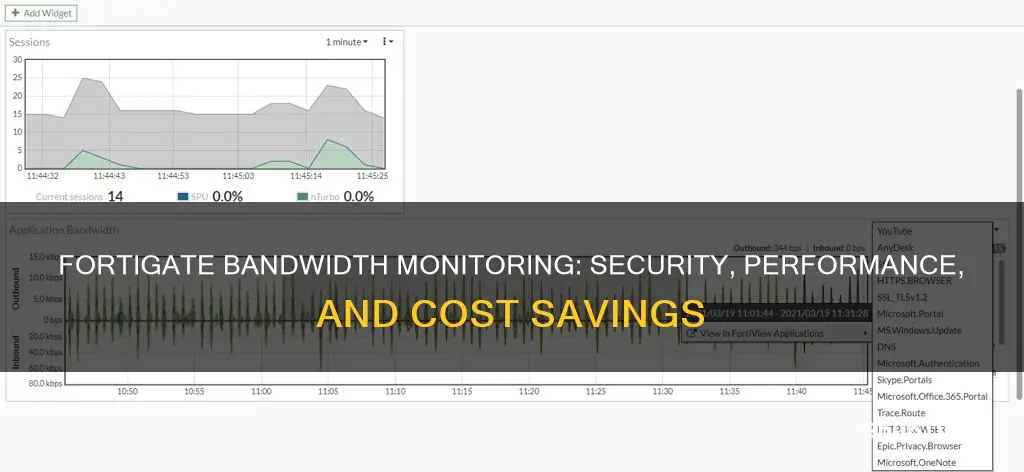
Monitoring bandwidth usage is essential for maintaining optimal network performance and security. With Fortigate, users can track and manage their internet connection's bandwidth utilisation through various tools and methods. This includes utilising the FortiGate Next Generation Firewall, which offers top-rated protection and high performance, as well as features like Fortiview, which provides detailed insights into bandwidth consumption. By understanding bandwidth usage, organisations can identify potential bottlenecks, ensure efficient resource allocation, and enhance their overall network security posture.
| Characteristics | Values |
|---|---|
| How to monitor bandwidth usage | Log in to FortiGate, go to Dashboard -> Main/Status, select the setting icon, choose 'Add Widget', then go to 'Monitor', select 'Interface Bandwidth' and select the interface |
| How to check bandwidth usage for a specific interface over a period of time | Use SNMP to extract interface usage into monitoring applications; for more detailed information, use NetFlow or sFlow |
| How to get bandwidth usage, session information and link performance status of the interface | Use the command: # diagnose sys link-monitor interface |
What You'll Learn
- Monitoring bandwidth usage can help identify bottlenecks and inefficiencies
- It can help to detect and troubleshoot network issues
- Bandwidth monitoring can help to optimise network performance
- It can help to identify and address security threats
- Bandwidth usage data can inform capacity planning and upgrade decisions

Monitoring bandwidth usage can help identify bottlenecks and inefficiencies
For example, if a particular application or user is consuming an excessive amount of bandwidth, it can lead to slowdowns for other users or applications. With this information, administrators can take steps to optimise bandwidth allocation, such as prioritising critical applications or users, or implementing quality of service (QoS) policies to ensure fair usage.
Additionally, monitoring bandwidth usage can help identify malicious activities or security breaches. For instance, if a sudden spike in bandwidth usage is detected, it could indicate a distributed denial-of-service (DDoS) attack or unauthorised data exfiltration. By monitoring bandwidth, administrators can quickly detect and respond to such incidents, mitigating potential damage.
Fortinet's FortiGate platform offers several tools for monitoring bandwidth usage. For instance, administrators can use the FortiGate CLI to retrieve bandwidth usage statistics for specific interfaces or the entire system. Commands such as "get system performance firewall statistics" and "get hardware nic interface" provide detailed information about network usage.
Furthermore, the FortiGate GUI allows administrators to visualise bandwidth usage through widgets and graphs. By adding an interface widget to the dashboard, administrators can easily monitor bandwidth utilisation for specific interfaces in real time. The GUI also provides a historical view of bandwidth usage, enabling administrators to identify trends and anomalies over time.
By leveraging these monitoring capabilities, administrators can effectively identify and address bottlenecks, inefficiencies, and security threats within their network infrastructure, ensuring optimal performance and security.
Monitoring Internet Usage: Tracking Activity by IP Addresses
You may want to see also

It can help to detect and troubleshoot network issues
Monitoring bandwidth usage is essential for detecting and troubleshooting network issues. By tracking bandwidth utilisation, administrators can gain valuable insights into network performance and identify potential bottlenecks or areas of congestion. This information can be used to optimise network configuration, allocate resources more efficiently, and ensure smooth data flow.
For example, if a Fortigate user notices high bandwidth usage on their Internet connection, they can utilise tools like Fortiview to identify the source of the issue. Fortiview allows users to order by bytes or bandwidth and filter by specific interfaces, helping to pinpoint which applications or users are consuming the most bandwidth. This information can then be used to make informed decisions about bandwidth allocation and network optimisation.
In addition to Fortiview, Fortinet offers a range of tools and commands to monitor bandwidth usage. Through the FortiGate CLI, administrators can access detailed information about link and link-monitor process status, including bandwidth usage, session count, latency, jitter, and packet loss. This data provides a granular view of network performance and can assist in troubleshooting specific issues.
Furthermore, Fortinet's GUI dashboard allows users to create widgets for interface bandwidth monitoring, providing a visual representation of bandwidth utilisation over time. This feature enables administrators to quickly identify spikes or anomalies in bandwidth usage, facilitating prompt issue detection and resolution.
By leveraging these tools and monitoring bandwidth usage, Fortigate users can proactively identify and address network issues, ensuring optimal performance, security, and reliability. With detailed insights into bandwidth consumption, administrators can make data-driven decisions to optimise their network infrastructure and deliver a seamless user experience.
Monitoring Employee Car Usage: Strategies for Effective Surveillance
You may want to see also

Bandwidth monitoring can help to optimise network performance
Additionally, bandwidth monitoring provides valuable insights into network traffic patterns and usage trends. By analysing bandwidth usage over time, administrators can identify peak usage periods, determine average bandwidth consumption, and forecast future bandwidth requirements. This information is crucial for effective capacity planning and network optimisation. It helps organisations make informed decisions about upgrading their network infrastructure, allocating resources efficiently, and optimising their network design to support business-critical applications.
Furthermore, bandwidth monitoring can help identify potential security threats and network anomalies. Abnormal bandwidth usage or spikes in traffic may indicate malicious activity, such as DDoS attacks or unauthorised data exfiltration. By monitoring bandwidth, administrators can detect such anomalies and take prompt action to mitigate security risks and protect the network.
Fortinet's FortiGate solutions offer comprehensive bandwidth monitoring capabilities. Through the FortiGate dashboard, administrators can add widgets to monitor interface bandwidth usage, both incoming and outgoing, in real time. FortiGate also supports SNMP (Simple Network Management Protocol), which allows for the collection and analysis of detailed interface usage data over time. This information can be visualised using monitoring applications or SNMP servers for deeper insights into network performance.
By leveraging FortiGate's bandwidth monitoring features, network administrators can make data-driven decisions to optimise network performance, allocate resources efficiently, and maintain a secure and reliable network environment for their organisation.
Monitoring Memory Usage in IIS: A Comprehensive Guide
You may want to see also

It can help to identify and address security threats
Monitoring bandwidth usage on Fortigate can help identify and address security threats by providing visibility into network activity and enabling the detection of anomalous behaviour. By tracking bandwidth utilisation, administrators can identify spikes or unexpected increases in traffic, which may indicate a potential security breach or malicious activity.
For example, a sudden increase in outgoing traffic could suggest unauthorised data exfiltration, while a spike in incoming traffic might indicate a distributed denial-of-service (DDoS) attack. With real-time bandwidth monitoring, security teams can quickly detect such anomalies and take prompt action to mitigate the threat.
Fortigate's bandwidth monitoring features, such as the ability to view interface bandwidth utilisation from the GUI, provide a comprehensive view of network traffic. This visibility enables administrators to establish a baseline of normal network behaviour and easily identify deviations from this baseline, enhancing their ability to detect and respond to security threats.
Additionally, Fortigate's granular network interface commands allow administrators to drill down into specific network interfaces, helping to pinpoint the source or target of a security threat. This level of detail aids in rapid threat containment and mitigation, minimising potential damage or disruption.
By leveraging Fortigate's bandwidth monitoring capabilities, organisations can strengthen their security posture and protect their networks from a range of potential threats, ensuring the confidentiality, integrity, and availability of their data and systems.
OpenLM's Actual Usage Time: Monitoring and Management Strategies
You may want to see also

Bandwidth usage data can inform capacity planning and upgrade decisions
Bandwidth usage data is a critical component of capacity planning and upgrade decisions. By monitoring bandwidth usage, organizations can gain valuable insights into their network utilization and make informed choices about their infrastructure needs.
For instance, if a company notices that their internet connection is consistently reaching maximum capacity during peak hours, they may consider upgrading their bandwidth capacity to avoid potential bottlenecks and ensure optimal performance. FortiGate's bandwidth monitoring tools can provide real-time data on interface utilization, helping organizations identify which applications or users are consuming the most bandwidth. This information can be used to make data-driven decisions about capacity planning and upgrades.
For example, if a specific application is found to be utilizing a significant portion of the available bandwidth, the organization may decide to allocate more resources to that application or optimize its bandwidth usage. Similarly, if a particular user or department is consistently consuming a large amount of bandwidth, the organization may need to reevaluate their network policies or consider upgrading their plan.
Additionally, FortiGate's bandwidth monitoring features can help identify potential security risks and inefficiencies in the network. By analyzing bandwidth usage trends and patterns, organizations can detect abnormal activity or unauthorized access attempts. This proactive approach to network management ensures that potential issues are identified and addressed before they impact performance or security.
Furthermore, the ability to monitor bandwidth usage over time allows organizations to make informed decisions about their future capacity needs. By understanding historical usage patterns and trends, organizations can forecast their bandwidth requirements and plan for scalability. This proactive approach ensures that the network infrastructure can keep pace with the organization's growth and evolving needs.
CPAP Usage Monitoring: Privacy or Health Concern?
You may want to see also
Frequently asked questions
Monitoring bandwidth usage on Fortigate can be done through the FortiGate GUI or CLI. To monitor via the GUI, log in to the FortiGate, go to Dashboard -> Main/Status, select the setting icon, and choose 'Add Widget'. Then, go to 'Monitor', select 'Interface Bandwidth', and choose the interface you want to monitor. To monitor via the CLI, use the following command:
```
diagnose sys link-monitor interface
```
Some tools that can be used to monitor bandwidth usage on Fortigate include FortiAnalyzer, FortiCloud, FortiView, SNMP, NetFlow, and sFlow.
Monitoring bandwidth usage on Fortigate can help identify bandwidth hogs, ensure optimal network performance, and troubleshoot connectivity issues. By monitoring bandwidth usage, network administrators can gain valuable insights into network traffic patterns, identify bottlenecks, and make informed decisions about network optimization.
To monitor bandwidth usage on a specific interface over a period of time on Fortigate, you can use SNMP to extract interface usage data into monitoring applications. If you need to analyse traffic on the network or transport layer, you can use sFlow or NetFlow.







